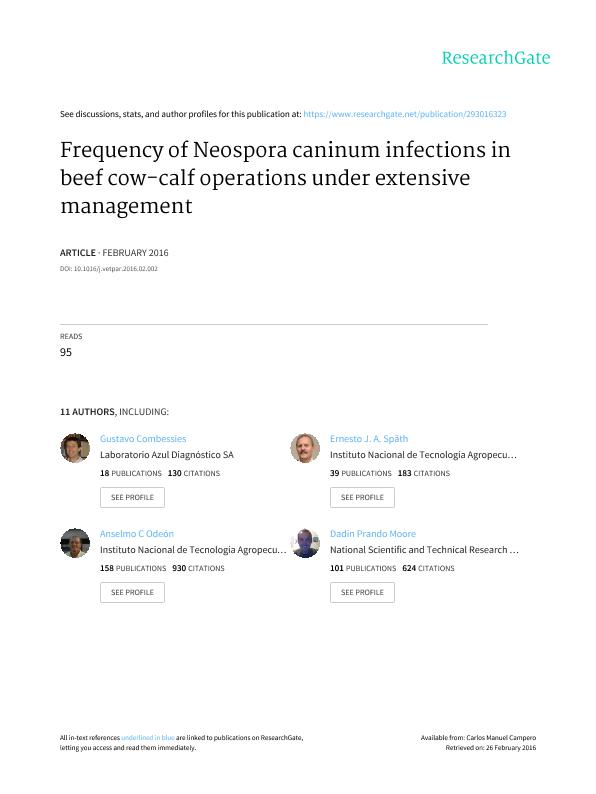Mostrar el registro sencillo del ítem
dc.contributor.author
Rodríguez, A. M.
dc.contributor.author
Maresca, Sebastián

dc.contributor.author
Cano, D. B.
dc.contributor.author
Armendano, J. I.
dc.contributor.author
Combessies, G.
dc.contributor.author
Lopéz Valiente, S.
dc.contributor.author
Odriozola, Ernesto Raul

dc.contributor.author
Späth, E.J.L.
dc.contributor.author
Odeón, Anselmo Carlos

dc.contributor.author
Campero, Carlos Manuel

dc.contributor.author
Moore, Dadin Prando

dc.date.available
2018-10-11T20:50:20Z
dc.date.issued
2016-03
dc.identifier.citation
Rodríguez, A. M.; Maresca, Sebastián; Cano, D. B.; Armendano, J. I.; Combessies, G.; et al.; Frequency of Neospora caninum infections in beef cow-calf operations under extensive management; Elsevier Science; Veterinary Parasitology; 219; 3-2016; 40-43
dc.identifier.issn
0304-4017
dc.identifier.uri
http://hdl.handle.net/11336/62265
dc.description.abstract
The aim of this study was to evaluate the frequencies of Neospora caninum horizontal and vertical transmissions in beef cow-calf operations under three different extensive management systems: group A: 0.75 head per hectare pasturing on natural grass; group B: 1.1 head per hectare on natural grass and improved cultured pastures; and group C: 2 head per hectare on natural grass, improved cultured pasture and whole corn silage. Serum samples from 72 multiparous cows assigned to each beef cow-calf operations were obtained every 3 months during 2 years. A group of 30 replacement heifers from each group were tested similarly since they were 10-21 months old. Twenty four, 20 and 34 calves from groups A, B and C respectively, were bled before colostrum intake and again 6 months later. The samples were analyzed by indirect fluorescence antibody test (IFAT) for detection of total IgG against N. caninum at a serological titre ≥200 for multiparous cows and replacement heifers, and a serological titre ≥25 for calves. Serum samples from seropositive cows were assessed by ELISA to evaluate the avidity of their specific antibodies. There were no differences in the proportion of seropositive cows from groups A, B and C at the beginning of the trial (p > 0.05). Interestingly, the lowest serological titres in seropositive cows from all groups were observed during the first trimester (p < 0.05). Although seropositive cows had medium to high avidity antibodies, suggesting chronic infection; seroconversion associated with low antibody avidity was found in 2, 3 and 3 seropositive cows from groups A, B and C. All replacement heifers remained seronegative. No abortions were recorded but 2, 1, and 2 calves from groups A, B and C were seropositive before colostrum intake, respectively. Seropositive calves born from cows having intermediate or high avidity remained with the same serostatus at 6 months of age. Even under varying extensive management conditions, both N. caninum horizontal and vertical transmission methods do occur in beef cow-calf operations.
dc.format
application/pdf
dc.language.iso
eng
dc.publisher
Elsevier Science

dc.rights
info:eu-repo/semantics/openAccess
dc.rights.uri
https://creativecommons.org/licenses/by-nc-sa/2.5/ar/
dc.subject
Beef Cattle
dc.subject
Neospora Caninum
dc.subject
Serology
dc.subject
Stocking Rate
dc.subject
Transmission
dc.subject.classification
Otras Ciencias Veterinarias

dc.subject.classification
Ciencias Veterinarias

dc.subject.classification
CIENCIAS AGRÍCOLAS

dc.title
Frequency of Neospora caninum infections in beef cow-calf operations under extensive management
dc.type
info:eu-repo/semantics/article
dc.type
info:ar-repo/semantics/artículo
dc.type
info:eu-repo/semantics/publishedVersion
dc.date.updated
2018-10-09T19:33:57Z
dc.journal.volume
219
dc.journal.pagination
40-43
dc.journal.pais
Países Bajos

dc.journal.ciudad
Amsterdam
dc.description.fil
Fil: Rodríguez, A. M.. Instituto Nacional de Tecnología Agropecuaria; Argentina
dc.description.fil
Fil: Maresca, Sebastián. Instituto Nacional de Tecnología Agropecuaria; Argentina
dc.description.fil
Fil: Cano, D. B.. Instituto Nacional de Tecnología Agropecuaria; Argentina
dc.description.fil
Fil: Armendano, J. I.. Universidad Nacional de Mar del Plata; Argentina
dc.description.fil
Fil: Combessies, G.. Laboratorio Azul; Argentina
dc.description.fil
Fil: Lopéz Valiente, S.. Instituto Nacional de Tecnología Agropecuaria; Argentina
dc.description.fil
Fil: Odriozola, Ernesto Raul. Instituto Nacional de Tecnología Agropecuaria; Argentina
dc.description.fil
Fil: Späth, E.J.L.. Instituto Nacional de Tecnología Agropecuaria; Argentina
dc.description.fil
Fil: Odeón, Anselmo Carlos. Instituto Nacional de Tecnología Agropecuaria; Argentina
dc.description.fil
Fil: Campero, Carlos Manuel. Instituto Nacional de Tecnología Agropecuaria; Argentina
dc.description.fil
Fil: Moore, Dadin Prando. Consejo Nacional de Investigaciones Científicas y Técnicas; Argentina
dc.journal.title
Veterinary Parasitology

dc.relation.alternativeid
info:eu-repo/semantics/altIdentifier/doi/https://dx.doi.org/10.1016/j.vetpar.2016.02.002
dc.relation.alternativeid
info:eu-repo/semantics/altIdentifier/url/https://www.sciencedirect.com/science/article/pii/S0304401716300279
Archivos asociados
